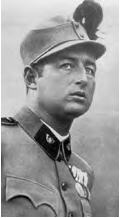- Ernst Rüdiger Starhemberg
: "This article is about the 20th century conservative politican. For the 17th century Austrian Fieldmarshal see
Ernst Rüdiger von Starhemberg ."Infobox Officeholder
name = Ernst Rüdiger Starhemberg
imagesize = 150px
small
caption =
order = Acting Federal Chancellor of Austria
term_start =July 26
term_end =July 29 ,1934
president =Wilhelm Miklas
predecessor =Kurt Schuschnigg (acting)
successor =Kurt Schuschnigg
order2 = 15th Federal Vice-Chancellor of Austria
term_start2 =May 1 ,1934
term_end2 =May 14 ,1936
chancellor2 =Engelbert Dollfuß
HimselfKurt Schuschnigg
predecessor2 =Emil Fey
successor2 =Eduard Baar-Baarenfels
birth_date =May 10 ,1899
birth_place =Eferding ,Austro-Hungary
death_date =March 15 ,1956 (aged 56)
death_place =Schruns ,Austria
constituency =
party = Patriotic Front
spouse =
children =
profession =Nobleman ,Military
education =
religion =Roman Catholic
footnotes =Ernst Rüdiger Starhemberg (
May 10 ,1899 ,Eferding -March 15 ,1956 ,Schruns ; Ernst Rüdiger Fürst von Starhemberg until the 1919 abolition of nobility) was an Austriannationalist politician prior toWorld War II .Born in
Eferding ,Upper Austria , in 1899, von Starhemberg hailed from a long line of Austrian nobles and inherited the title ofprince . He was the oldest son of PrincessFranziska von Starhemberg and Prince Ernst Rüdiger von Starhemberg. He was a colleteral relative to Field MarshalErnst Rüdiger von Starhemberg . InWorld War I he served on the Italian Front and then in 1921 was a member ofFreikorps Oberland .As a young man, he became a proponent of
Catholic andconservative politics and joined theHeimatschutz , quickly becoming a leader of one of its local branches. He also became an admirer ofBenito Mussolini and hisFascist government. In the early 1920s, Starhemberg traveled toGermany and had contacts with the nascentNazi movement.Adolf Hitler actively used Starhemberg’s status as an Austrian noble to try to improve the party’s image and to attract wealthy and influential backers to its ranks. After seeing the failedBeer Hall Putsch of 1923, Starhemberg became disenchanted with Nazism and returned to Austria. Rejoining the Heimatschutz, Starhemberg became its national leader in 1930 and actively campaigned to turn Austria into a more organized state. Eventually, Starhemberg’s movement became powerful enough to influence the government, and as such the chancellor appointed himMinister of the Interior in September of 1930. Starhemberg resigned his position shortly thereafter, however, when the Heimwehr’s political wing did poorly in Parliamentary elections.When conservative
Engelbert Dollfuß becameChancellor of Austria in 1932, Starhemberg once again gained governmental power. At Dollfuß’s request, Starhemberg worked to combine a number of right-wing groups into a single political entity. He was successful, and the result was the powerful Fatherland Front. For his efforts, Starhemberg became Dollfuß's vice chancellor in May of 1934. When Dollfuß was assassinated two months later during a failed coup by the Nazis, Starhemberg became leader of the Fatherland Front. He also retained his position as vice chancellor underKurt Schuschnigg , and became Minister of State Security as well. With these positions, Starhemberg was in effect the second most powerful man in Austria. During this time period, he fought to keep Austria an independent state and fervently opposed Austrian Nazis and their support of a union with Germany. In 1936, however, he was forced out of power by Schuschnigg, who, inspired by theappeasement policies of the western democracies, disagreed with Starhemberg’s opposition to the Nazis. After theAnchluss in 1938, Starhemberg fled the country and served in the British andFree French air forces for a short period of time at the beginning ofWorld War II . In 1942 he traveled toArgentina and lived there until 1955, after which time he returned to Austria to die. He died inSchruns in 1956.Notes
Wikimedia Foundation. 2010.
